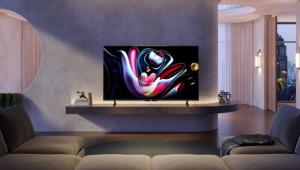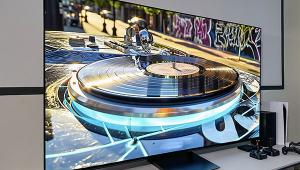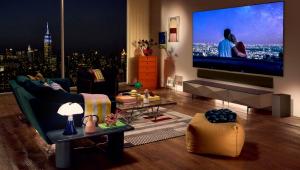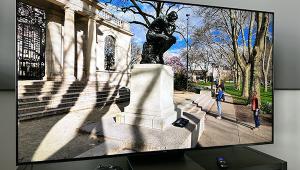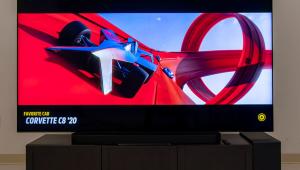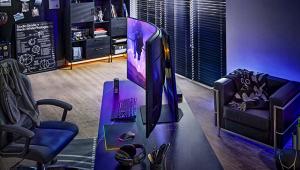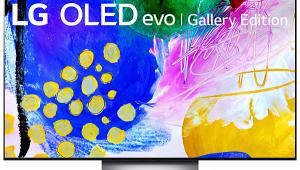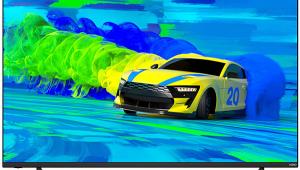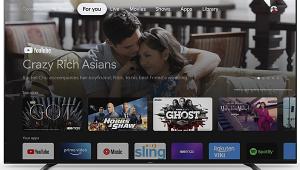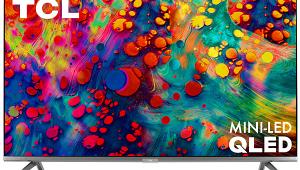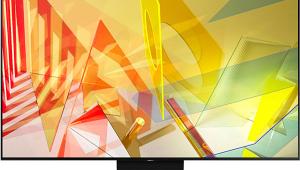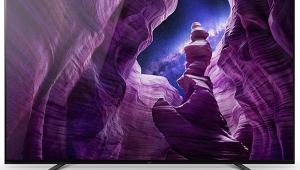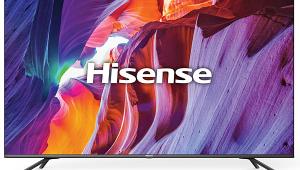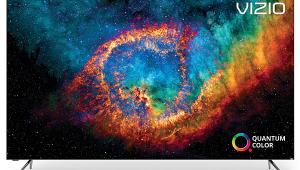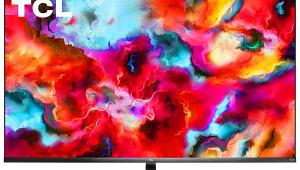Seems like a work in progress..
Vizio RS65-B2 LCD Ultra HDTV Review

AT A GLANCE
Plus
Full Ultra HD capability including HDR and wide color
Superb blacks and shadow detail
Integrated soundbar with subwoofer and surrounds
Minus
Expensive
HDR limited to Dolby Vision
Ineffective color management system (CMS)
2D only
THE VERDICT
Most current 4K sets deliver only the 4K slice of Ultra HD’s full pie. The RS65-B2 goes all the way, including 4K resolution, advanced color, and high dynamic range.
In a recent review of Vizio’s relatively affordable M65-C1 Ultra HDTV, I reflected on that company’s vision in having “sale prices low enough to attract millions of buyers.” But reality has a way of intruding on a dream, and a state-of-the-art Ultra HD set isn’t cheap to produce. With its new, two-model Reference Series (the 120-inch RS120B3, which sells for $130,000, and the 65-incher under review here), the company now challenges the thin-aired peaks of cost-no-object sets previously dominated by older, more established brands. In fact, only selected dealers and some custom installers even carry the Reference Series.
Out of the Box
The Vizio arrived in a huge box—at just over 7 feet long and nearly 175 pounds, you’re not going to just toss this set into the back of your SUV to drive it home. The reason for the massive box is that it also includes a soundbar, subwoofer, and surround speakers, with every piece in its own separate box inside the big one.
You read that right: soundbar, sub, and surrounds. You can either mount the soundbar on the set itself or separately. The sub is wireless, and the surrounds are powered by amps built into the subwoofer. You don’t have to use the soundbar and its accoutrements (though without them, the set has no audio), but you can’t buy the set without it. And according to Vizio, it will work only with the RS65-B2. So if you don’t need it because you already have a good audio system, Aunt Bea won’t be able to use it, either. Nor will selling it on eBay be an option to help offset the cost of the set. These audio accessories won’t be discussed further here, but I’ll comment on them in an addendum in the online version of this review (soundandvision.com).
Once you get the set and accessories unpacked, setup is relatively easy for two people. But be aware, the set is far heavier than your typical, modern 65-incher, particularly with the soundbar and stand attached. Sixty-one of the Installation Guide’s 75 pages are devoted to various possible setups, but a more extensive onscreen e-manual is available both in the set’s menus and on Vizio’s Website.
Walkabout
The Vizio is the model of a modern major UHD, whose loaded feature complement is lacking only home 3D video playback (a feature Vizio has dropped from all of its sets). There’s no voice or motion control, either, but a full range of video adjustments is provided, including some we always use and more than a few we always leave either off or in default mode.

Three of these controls are dedicated to motion blur reduction: Reduce Judder, Reduce Motion Blur, and Clear Action. The latter appears to be a dark- or black-frame insertion feature, designed to reduce motion blur without the typical soap opera effect of the other two. It worked to a degree, though it does reduce brightness. But you can regain the latter if, like us, you have plenty of increased Backlight steps available. Nevertheless, I left all three of these motion compensation features off.
An Ultra Color Spectrum control has two settings for color gamut, Standard and Expanded. In the default Standard, the set will accurately display Rec. 709 HD content and also automatically detect Dolby Vision HDR content (more on that shortly) and switch automatically to the appropriate wide color space. The Expanded setting, which can be selected manually, only has an effect on 4K content and pushes the color points out as far as possible. It sometimes had a dramatic effect on 4K material with lots of bright greens and, in particular, reds.
The RS65-B2’s Smart TV feature offers a full range of the most popular Web-based apps. It also provides full access to the Web, where you can download additional apps. And as with all modern sets, you can also watch videos, view photos, and listen to music stored on your home network, either wired or wirelessly. (One caveat: The Vizio does not decode Google’s VP9 codec, which is required for viewing 4K content from You Tube.)
 The set’s small remote control isn’t backlit, which at first made it a little annoying to deal with in a dark room, though I soon became accustomed to using it by feel. The back of the remote includes a keyboard, handy for those who plan to do a lot of Web browsing (though it didn’t function for me on the Vudu sign-in page). In any event, given the cost and distribution of this set, there’s a possibility that the end user will have some sort of universal control system.
The set’s small remote control isn’t backlit, which at first made it a little annoying to deal with in a dark room, though I soon became accustomed to using it by feel. The back of the remote includes a keyboard, handy for those who plan to do a lot of Web browsing (though it didn’t function for me on the Vudu sign-in page). In any event, given the cost and distribution of this set, there’s a possibility that the end user will have some sort of universal control system.
Advanced Color and High Dynamic Range
While at present, all UHD models, even the cheapest, offer 4K resolution (3840 x 2160), there’s much more than that to the full Ultra HD spec. High dynamic range (HDR) and advanced color are also included, though only some UHD sets offer one or both of these. Wider color with most UHD sources, at least those we’re likely to get in the near term, means P3, the color gamut you experience in a digital cinema, plus 10-bits-per-color bit depth (up to now, video sources and displays have been limited to 8 bits). Two measly bits doesn’t sound like much, but they are. They’ll offer finer gradations, with less of the color banding (often called false contouring) you sometimes see with 8 bits on large areas of the same color as they transition gradually from one brightness level to another.
The jump from 1080p’s 2K resolution to 4K is rarely visible on any consumer-sized set. And wider color and advanced bit depth is often subtle. But high dynamic range was developed to produce (with properly encoded source material) brighter and better-defined highlights in otherwise normally bright scenes. The effect, with properly encoded source material and setup, may be the most clearly visible and dramatic element of Ultra HD.
Vizio’s RS65-B2 offers the whole Ultra HD package. The company claims that the set’s available color gamut exceeds the requirements of P3 color. They also say that the RS65-B2 achieves close to 87 percent of Rec. 2020, an even wider (and somewhat controversial) gamut built into the UHD standard but that we don’t expect to see in consumer source material any time soon. The set also offers 10-bit capability from input to screen, meaning it won’t downgrade 10-bit content if and when that arrives.
In order to achieve these wider color gamuts, the RS65-B2 uses quantum dots for its backlighting. Quantum dots emit color when hit by the light from a blue LED; the color of the light depends on the size of the dot. When used in an LCD set, the emission is either red or green, which in combination with the blue LEDs, produces the set’s backlighting and color.

These elements are imbedded in a film located behind the screen rather than at its sides. That’s an ideal setup for full backlighting with local (zone) dimming, a process that can significantly improve black levels. Vizio makes more extensive use of this technique than any other manufacturer we know of. Even its cheapest sets employ it, though the number of zones in those designs is limited to keep costs down—usually 64 zones or less, sometimes much less. The RS65-B2 has an impressive 384 zones.
And the more zones, the more precisely a set can pinpoint those small, bright highlights—the highlights that will be targeted in a high dynamic range (HDR) source—without the light spilling over into darker parts of the picture. The RS65-B2 has been specifically designed to handle the Dolby Vision HDR format. Other HDR formats are also jockeying for position in the market, but no standard has yet been adopted. Vizio has assured us that units in the field will be upgradable with firmware to handle other types of HDR should they choose to do so, specifically to the HDR10 format that has been adopted by Samsung, Sony, and LG, and which would require, among other changes, an update of the RS65-B2’s HDMI 2.0 ports to HDMI 2.0a. In an official response to our query, though, the company was clear it has no immediate plans to do so, and that “Currently, Vizio is focused on the Dolby
Vision format that we feel is technologically superior and has substantially better picture quality resulting from a proper implementation of high dynamic range and extended color gamut.” It is Vizio’s view that the technology in the Reference Series combined with the remastered Dolby Vision content made available for streaming on Vudu (some 18 titles as of late November) “already surpasses what is possible with HDR10.” On the other hand, if the company chooses not to upgrade these sets for HDR10 and a substantial quantity of HDR10 content can only be played back as standard dynamic range UHD, we’ll be the first to report on the torch and pitchfork parades.
2K Performance
Starting with HD (not UHD) source material, the Vizio displayed a few glitches on our usual round of video tests. In the recommended Auto setting for Film Mode, it borderline failed both the 3:2 HD and 3:2 SD challenges based on torture test material we use to expose such shortcomings (the “racetrack” clip on the original Spears & Munsil test disc). But in many hours of watching real-world 1080i and 720p material, I saw nothing out of the ordinary that couldn’t be blamed on the source. Its chroma resolution was also borderline, with a clearly visible rolloff on the uppermost burst pattern. But some designers deliberately roll off the chroma at the top end, and this did not affect the visible color. It’s a fairly common shortcoming in our test results.
- Log in or register to post comments


Should a TV, a TV, something bought for image quality, really receive a Top Pick when it has such faults? Have we so lowered our expectations due to a lack of truly high performance displays?

I would think most people dumping six grand into their set would have a nice home theatre sound setup of their own. Maybe it's just me.

384 zones for the vizio... Seeing the backlight for the new Sony Master Drive set made me realize that all we need to do is create a direct white led display with a resolution of 720*480 and slap filters, diffusers, etc and the LCD panel. With a 480p direct led display each pixel is controlled individually and boom! Best LCD ever!
Ideally.. I would love to see an ILED... Inorganic LED Display!

Input lag measurements have become very important in modern TV reviews. Use of a Leo Bodnar input lag tester should be part of standard measurement equipment and only takes about 20 seconds to plug in and measure.
Do you have plans to add input lag measurements to your reviews?


